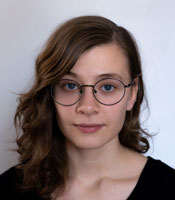
Emily (she/they) is a new media artist, science communicator, and writer. Their work questions the intersection of science, art, and technology—with particular interest in how those veins cross at the concept of empathy. Emily holds BAs in Psychological Science and Studio Art from Gustavus Adolphus College and additionally studied Fine Arts Media at the Slade School of Fine Art.
Their work has been shown at the Target Gallery, the American Swedish Institute, Rosalux Gallery, Highpoint Center for Printmaking, Gustavus Adolphus College, and the School of Visual Arts in New York. They have received funding through the National Science Foundation, the Minnesota State Arts Board, Springboard for the Arts, and Gustavus Adolphus College. Currently, Emily works as a communications associate for the Bell Museum and a studio manager at Second Shift Studio Space.
Emily has a long history of collaborating with environmental scientists to translate research into art, and field work and data into experiences that connect participants to landscapes and projects. During their residency year, Emily will dive into Cedar Creek's long-term datasets in their project Feeling Data. Emily writes:
Much of my work is about empathy—broadly—in that, I’m curious about how we relate to each other and the world around us. Increasingly, I’m interested in how we can empathize with data. Often, when art is used to transmute data into a physical form, we can feel it and relate to it in ways that we typically can’t when it is a graphical representation.
Over the course of the residency, I [will] experiment with the different ways we can feel data. This might result in data visualization, sonification, tactile or olfactory presentations of data, or interactive components. The project [will] manifest as a publicly accessible website that would host all of these experiments. I’m excited by the idea of seeing the hard, quantitative data and also being able to pair it with the qualitative experience of being at the reserve.